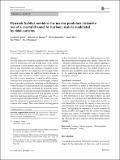Files in this item
Dynamic habitat corridors for marine predators : intensive use of a coastal channel by harbour seals is modulated by tidal currents
Item metadata
| dc.contributor.author | Hastie, Gordon Drummond | |
| dc.contributor.author | Russell, Deborah Jill | |
| dc.contributor.author | Benjamins, Steven | |
| dc.contributor.author | Moss, Simon | |
| dc.contributor.author | Wilson, Ben | |
| dc.contributor.author | Thompson, David | |
| dc.date.accessioned | 2016-11-02T16:30:16Z | |
| dc.date.available | 2016-11-02T16:30:16Z | |
| dc.date.issued | 2016-12 | |
| dc.identifier | 245970208 | |
| dc.identifier | 7ae7596c-d5fe-49bc-b500-85a90d2ffad6 | |
| dc.identifier | 84991106947 | |
| dc.identifier | 000387656900016 | |
| dc.identifier.citation | Hastie , G D , Russell , D J , Benjamins , S , Moss , S , Wilson , B & Thompson , D 2016 , ' Dynamic habitat corridors for marine predators : intensive use of a coastal channel by harbour seals is modulated by tidal currents ' , Behavioral Ecology and Sociobiology , vol. 70 , no. 12 , pp. 2161–2174 . https://doi.org/10.1007/s00265-016-2219-7 | en |
| dc.identifier.issn | 0340-5443 | |
| dc.identifier.other | ORCID: /0000-0002-1969-102X/work/49052067 | |
| dc.identifier.other | ORCID: /0000-0002-9773-2755/work/54819199 | |
| dc.identifier.other | ORCID: /0000-0003-1546-2876/work/56862190 | |
| dc.identifier.uri | https://hdl.handle.net/10023/9752 | |
| dc.description | The work was funded by the UK’s Natural Environment Research Council, the Department for Environment Food and Rural Affairs (RESPONSE project, NE/J004251/1 and NERC National Capability SMRU1001), Scottish Natural Heritage and Marine Scotland | en |
| dc.description.abstract | Previous studies have found that predators utilise habitat corridors to ambush prey moving through them. In the marine environment, coastal channels effectively act as habitat corridors for prey movements, and sightings of predators in such areas suggest that they may target these for foraging. Unlike terrestrial systems where the underlying habitat structure is generally static, corridors in marine systems are in episodic flux due to water movements created by tidal processes. Although these hydrographic features can be highly complex, there is generally a predictable underlying cyclic tidal pattern to their structure. For marine predators that must find prey that is often patchy and widely distributed, the underlying temporal predictability in potential foraging opportunities in marine corridors may be important drivers in their use. Here we used data from land-based sightings and nineteen harbour seals (Phoca vitulina) tagged with high-resolution GPS telemetry to investigate the spatial and temporal distribution patterns of seals in a narrow tidal channel. These seals showed a striking pattern in their distribution; all seals spent a high proportion of their time around the narrowest point of the channel. There was also a distinctive tidal pattern in the use of the channel; sightings of seals in the water peaked during the flood tide and were at a minimum during the ebb tide. This pattern is likely to be related to prey availability and/or foraging efficiency driven by the underlying tidal pattern in the water movements through the channel. | |
| dc.format.extent | 14 | |
| dc.format.extent | 1605368 | |
| dc.language.iso | eng | |
| dc.relation.ispartof | Behavioral Ecology and Sociobiology | en |
| dc.subject | Foraging | en |
| dc.subject | Marine mammal | en |
| dc.subject | Oceanographic | en |
| dc.subject | Predator | en |
| dc.subject | Pinniped | en |
| dc.subject | Diving | en |
| dc.subject | GC Oceanography | en |
| dc.subject | QH301 Biology | en |
| dc.subject | QL Zoology | en |
| dc.subject | NERC | en |
| dc.subject | SDG 14 - Life Below Water | en |
| dc.subject.lcc | GC | en |
| dc.subject.lcc | QH301 | en |
| dc.subject.lcc | QL | en |
| dc.title | Dynamic habitat corridors for marine predators : intensive use of a coastal channel by harbour seals is modulated by tidal currents | en |
| dc.type | Journal article | en |
| dc.contributor.sponsor | NERC | en |
| dc.contributor.institution | University of St Andrews. School of Biology | en |
| dc.contributor.institution | University of St Andrews. Sea Mammal Research Unit | en |
| dc.contributor.institution | University of St Andrews. Marine Alliance for Science & Technology Scotland | en |
| dc.contributor.institution | University of St Andrews. Scottish Oceans Institute | en |
| dc.contributor.institution | University of St Andrews. Centre for Research into Ecological & Environmental Modelling | en |
| dc.identifier.doi | https://doi.org/10.1007/s00265-016-2219-7 | |
| dc.description.status | Peer reviewed | en |
| dc.identifier.grantnumber | NE/J004251/1 | en |
This item appears in the following Collection(s)
Items in the St Andrews Research Repository are protected by copyright, with all rights reserved, unless otherwise indicated.

